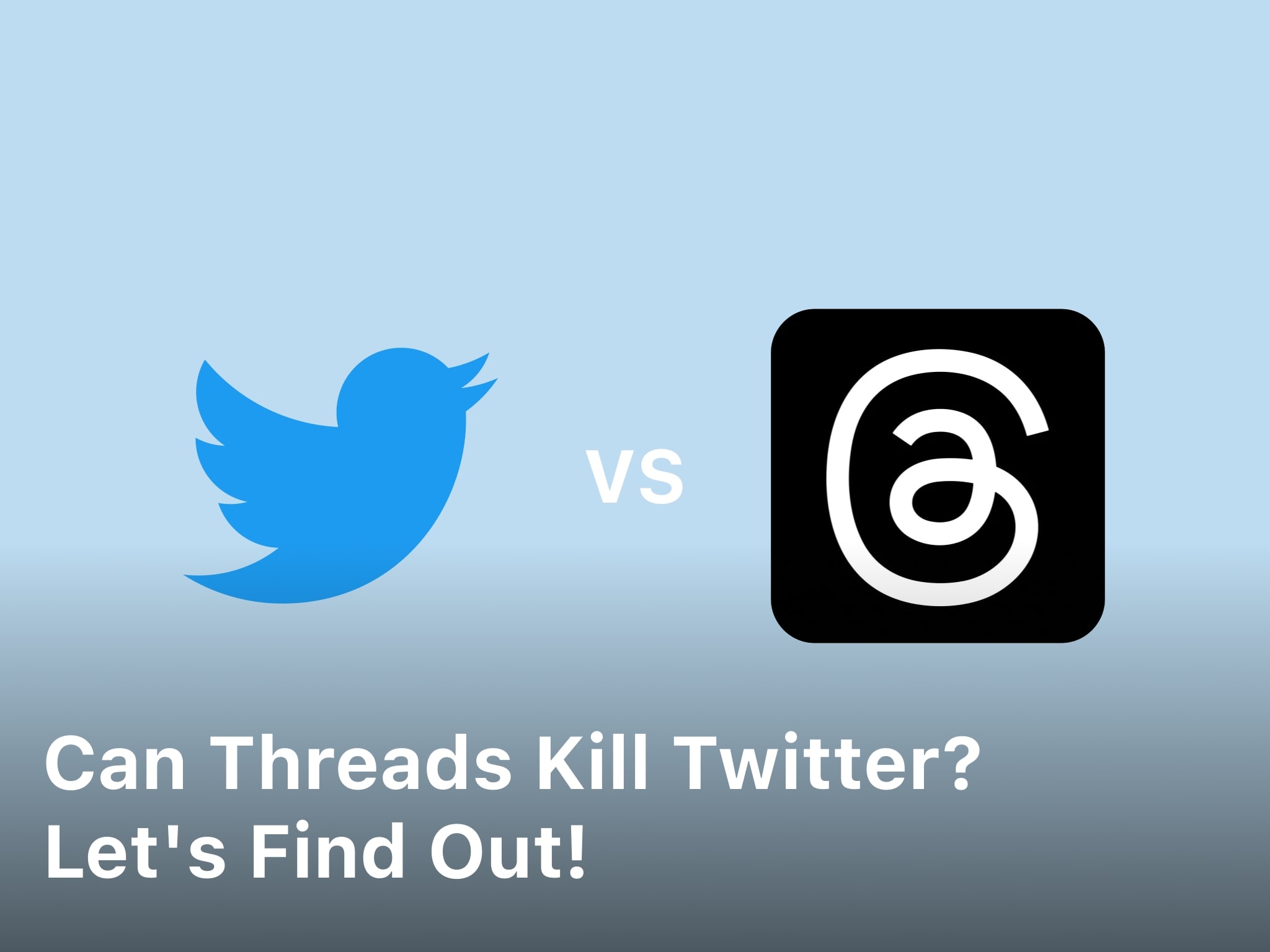Can Threads Kill Twitter? Let’s Find Out!
https://bulkyvpn.com/ – Can Threads Kill Twitter? Let’s Find Out!. In today’s digital age, social media platforms play a vital role in connecting people from around the world. Twitter, known for its real-time microblogging and concise communication, has been a prominent player in the social media landscape.
However, with the emergence of threads apps, a question arises: Can Threads Apps kill Twitter? In this article, we will explore the impact of threads apps on Twitter and delve into their potential to disrupt the microblogging giant.
Ever wonder if Twitter might be on its way out, replaced by the new kid on the block – Threads apps? You wouldn’t be alone. Twitter has been the king of microblogging for over a decade but some cracks are starting to show. As a Twitter fan, you’ve probably noticed how threads have become increasingly popular.
Those long, connected tweets that tell a story or share an idea. Threads give you more space and flexibility to share your thoughts without being limited to 280 characters. Apps like Thread Reader and UnrollMe have made threads easier to read by compiling connected tweets into a single, scrollable page.
Can Threads Kill Twitter?
Threads apps are third-party apps that make it easy to create and read threads on Twitter. Threads are a series of connected tweets that tell a story or share information on a topic. Apps like Thread Reader, Unroll, and Threadify have gained popularity because they compile an entire thread into an easy-to-read article format.
Why are people turning to these thread apps? A few reasons:
- Easier to read. Scrolling through a series of tweets can be tedious and disjointed. Thread apps reformat threads into a coherent article with proper formatting, spacing and images embedded.
- Avoid the noise. Twitter is filled with distractions – likes, comments, retweets, and notifications. Thread apps strip away the clutter and just show the thread content.
- Search and discover. These apps make threads more discoverable. You can search for topics that interest you and find threads discussing those subjects. Within the apps, threads are also categorized and tagged to aid discovery.
- Save and share. Thread apps allow you to save favorite threads in one place for easy access later. You can also easily share threads with others via a simple link.
While Twitter remains the platform for creating and sharing threads, thread apps enhance the experience by making these tweetstorms more readable, searchable and shareable.
Keep Reading : The Meta Twitter Clone
For many users, thread apps and Twitter seem to co-exist quite happily. So, can thread apps kill Twitter? Unlikely. But they do make the service more useful for those who love a good thread!
How Thread Apps Challenge Twitter
Thread apps like Thread Reader and Threadify are challenging Twitter’s dominance as the place for having public conversations on the internet. Here’s how:
These dedicated thread apps make long-form Twitter threads much more readable. On Twitter, you have to tap through each tweet in a thread manually. But with a thread app, tweets are automatically stitched together into a single, scrollable page. No more tapping, just scrolling.
Thread apps also add useful features for saving, searching, and sharing threads. You can bookmark favorite threads, search a library of threads by topic, and share a link to an entire thread rather than having to share each tweet individually.

Some argue that the rise of thread apps could reduce Twitter engagement since people are interacting less with individual tweets. However, others counter that thread apps simply enhance the Twitter experience, making longer threads more accessible and shareable. Thread apps may be complementary rather than competitive.
Either way, the popularity of thread apps demonstrates that people want to have more in-depth conversations and tell more complete stories on social media. If Twitter wants to maintain its status as the place for public discussion and idea-sharing, it may need to make longer-form content and threads a bigger part of its platform. The age of the soundbite is over; nuanced conversations are what engage us now.
Thread apps have thrown down the gauntlet, challenging Twitter to up its game. The question remains: will Twitter step up to the challenge or be killed by the very threads it helped create? The plot thickens!
Can Twitter Adapt to Compete With Thread Apps?
Twitter has dominated social media for over a decade, but recently new thread apps have emerged to challenge it. Can Twitter adapt to compete? Let’s explore.
Twitter’s success comes from its simplicity. You get 140 characters to share your thoughts. Thread apps expand on this by letting you create longer posts, or “threads,” up to 5,000 characters. For some, this extra space is appealing and allows for more nuanced conversations.
However, Twitter still has a few advantages. First, it has an established base of over 300 million monthly active users. Thread apps are still relatively small, with the largest, Thread Reader App, reaching just 3 million users. Twitter also has deals with media companies and tools for following news, celebrities and events. Its platform is tried and true.
That said, Twitter needs to make some changes to avoid losing users to thread apps. A few options:
- Increase the character limit. Bumping it up to 280 or even 500 characters could satisfy those wanting more space while still keeping the signature brevity.
- Improve threading features. Make it easier to link tweets together in a thread and to read long threads. Add tools for re-sharing and liking whole threads.
- Court popular thread creators. Work with influential users who create long-form threads to post more of their content natively on Twitter. Give them promotions and spotlight their threads.
- Buy a thread app. If you can’t beat ’em, acquire ’em. Buying an existing thread app and integrating its features into Twitter could eliminate a competitor and give users the best of both worlds.
While thread apps pose a threat, Twitter still has significant advantages. By making small changes to give users more flexibility in how they post and engage, Twitter can thrive along with—or instead of—the thread apps. The social network just needs to keep up with the times to avoid being left behind. Overall, the future remains uncertain but promising for this platform if the right strategic moves are made.
Will Thread Apps Ultimately Replace Twitter?
Will dedicated threads apps ultimately replace Twitter? It’s hard to say for sure, but here are some points to consider:
Threads apps offer a dedicated space focused entirely on long-form conversations and storytelling. For those who love crafting and following threads, a tailored app provides an optimized experience without the noise and distractions of Twitter. However, Twitter still has the major advantage of scale and network effects. Your threads may reach more people and gain more traction on Twitter simply because the potential audience is so much larger.
For now, threads apps and Twitter seem to co-exist peacefully. Many thread creators cross-post to both platforms to maximize reach, and fans follow their favorite threaders wherever they’re active. But if one platform gains a strong advantage, the balance could shift.
If threads apps continue gaining mainstream popularity and adoption, they may pose a real threat to Twitter. On the other hand, if Twitter doubles down on optimizing the threads experience on their platform, threads apps could end up relegated to a niche audience.
At this point, the future remains unclear. But one thing is for sure – the demand for long-form, multi-tweet stories and conversations will only continue to grow. Whether that takes place primarily on Twitter or dedicated threads apps, or a combination of both, threads are here to stay. The platforms and formats may evolve, but the human desire for sharing stories, ideas and meaningful discussions will endure.
For now, the best approach is to choose the platform(s) that suit your needs and style. As a creator or consumer of threads, you have options. And options are always good. Threads have empowered more voices to emerge and engage in today’s virtual public square. So whichever direction this unfolds, the spread of threads is helping foster connection and open exchange between people around the world.
The Future of Microblogging: Threads vs. Tweets
Threads apps are the new kid on the block in the world of microblogging. They offer a different experience than tweets on Twitter, but will they eventually replace tweets altogether? The future is hard to predict, but here are some possibilities:
Threads provide a way to share longer, multi-part thoughts by connecting tweets together. You can add context that typically doesn’t fit in a single 280-character tweet. Threads may appeal more to those looking to share stories, experiences or more in-depth opinions. However, threads can be harder to read and follow compared to standalone tweets. Not everyone wants to read a 50-tweet thread!
Keep Reading : Threads is Official Launch Now
Twitter has taken notice of the popularity of threads and added “tweetstorms” – the ability to connect multiple tweets together in a thread. This shows Twitter sees value in longer-form content. At the same time, Twitter’s core experience remains centered around short, quick-to-consume tweets. As long as this remains the case, threads are unlikely to replace tweets.
New social networks built around threads, like Thread Reader App, offer an experience focused entirely on long-form posts. These could pose a threat to Twitter if they gain major popularity and engagement. However, migrating users is difficult, and Twitter’s established base and brand recognition provide a strong advantage.
In the end, threads and tweets may continue to co-exist, each serving a different need. Threads allow for more in-depth sharing, while tweets remain ideal for quick updates, news sharing, reactions and short quips. The future of microblogging will depend on how well networks can incorporate both of these formats to create an optimal experience for users. The company that finds the right balance may have the best chance of success in the years to come.
Conclusion
Well Can Threads Kill Twitter? So there you have it, the pros and cons of threads apps and whether they’ll ultimately doom Twitter. Only time will tell if these new tools gain enough mainstream popularity to truly threaten Twitter’s dominance.
As with any new technology, there will likely be an initial surge of interest that levels off. While threads apps may never completely replace Twitter, at a minimum they’ll likely push Twitter to up their game by improving features and the overall user experience. Competition is good for innovation.
For now, you have options and can use threads apps and Twitter together or stick to just one. The choice is yours. Let the great social media experiment continue!




